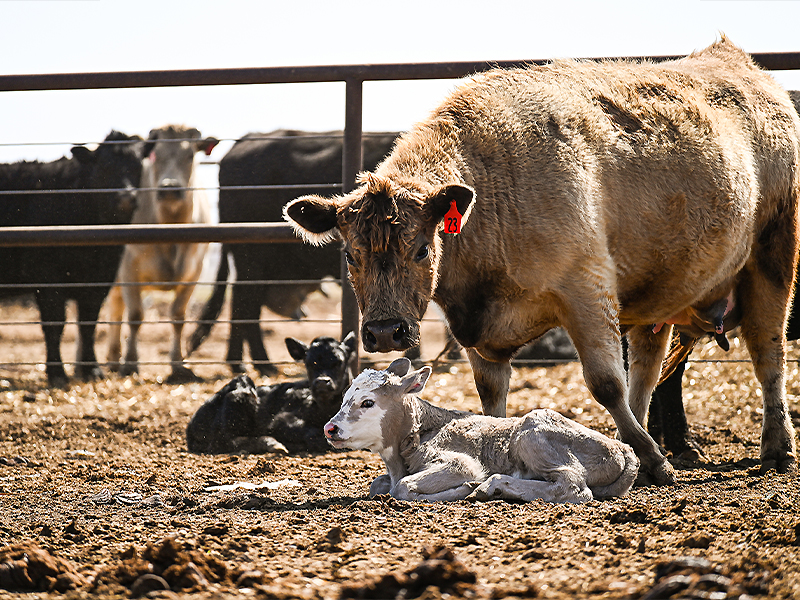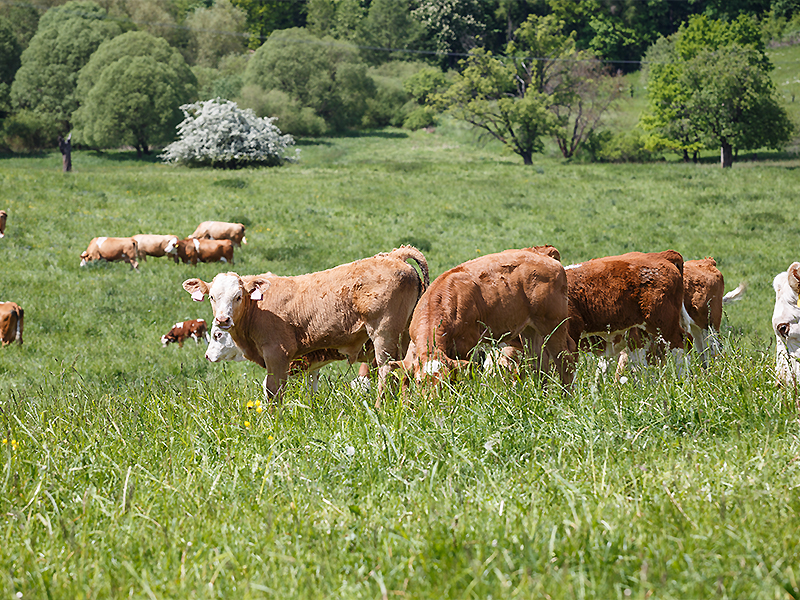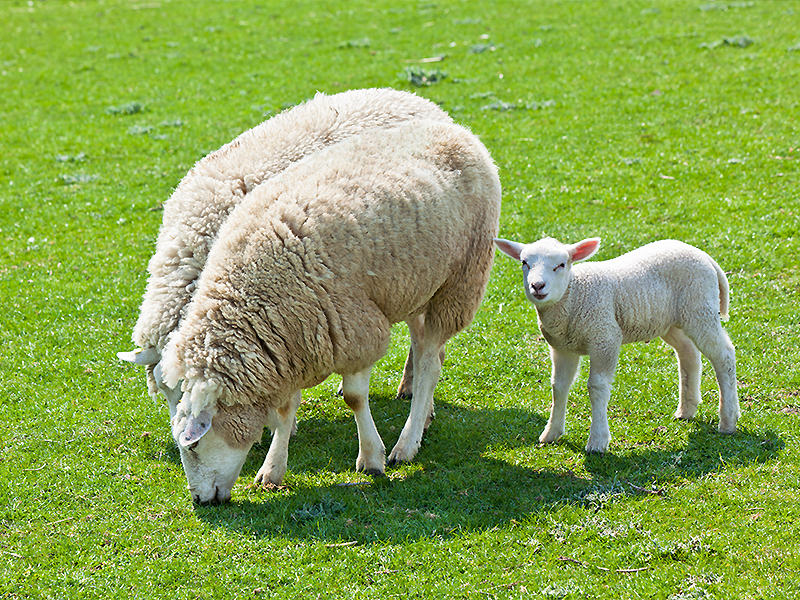
Spring’s warming temperatures, green grass, and thunderstorms are just around the corner. For ranchers, spring brings an added and exciting meaning. To them, it’s a season of new life on their ranch.
This is the time of year when cattle, sheep or goat owners have one thing in common: calving, lambing and kidding. This is an exciting but stressful time of year for livestock owners. Experts from the Texas Tech University School of Veterinary Medicine explained, proper preparation of animals and facilities can lead to success.
Calving Season Preparation
One of the most common reasons for calf loss in the beef cattle industry is calving difficulty, also known as dystocia. This is characterized when the act of giving birth is prolonged and cannot be completed without some sort of assistance, which is surprisingly common in the U.S.
“In the U.S., the most significant cause of dystocia is fetal-maternal mismatch – when the calf is too large to fit through the birth canal due to fetal oversize or maternal body frame,” said Jennifer Koziol, associate professor of food animal medicine and surgery. “Second on the list is fetal malpresentations – when the calf is not positioned correctly to enter the birth canal.”
That’s why it is very important to recognize when labor is abnormal or when the timing is prolonged because there are ways to minimize those abnormalities with appropriate and early intervention.
Tip No. 1 – Check on Your Cows Frequently
The average length of gestation for cattle is about 280 days, with the normal range between 273 and 296 days. It is also noted that cows typically deliver a calf within 30 minutes and heifers within one hour following the start of active labor.
It is highly recommended for cattle owners to make frequent observations so they can make timely interventions when dealing with dystocia. As the calving date for a herd approaches, owners should check on their cows at least twice daily while heifers should be checked every two to four hours.
“Since getting up in the middle of the night is not always as enjoyable as evaluating your cattle during the day, you can influence calving time by adjusting when you feed your pregnant cattle,” said Blaine Johnson, assistant professor of food animal medicine and surgery. “This is called the Konefal method, where you feed your cattle toward the end of the day (say 4 p.m.).
“By switching the timing of feeding, researchers have shown 70%-80% of cows calved
between 6 a.m. and 6 p.m. There are caveats to this method, such as you need to start
two weeks prior to the start of calving season and be aware of impending weather,
such as drops in barometric pressure, that will have greater influences on calving
timing.” 
Tip No. 2 – When to Intervene or Call Your Veterinarian
When cattle owners observe their cows or heifers, it’s important for them to know when to intervene or call their veterinarian for assistance. There are six signs that cattle owners should be aware of when checking on their cows.
First, if you suspect the cow has been in stage one labor for more than eight hours, owners should call their veterinarian. Stage one is the beginning of uterine contractions, dilation of the cervix, and ends with the classic “water breaking” – this stage typically lasts two to six hours.
Second, if only the water bag is visible and no progress is made within one hour, owners should call their veterinarian.
Third, if the feet are showing with their soles pointed down toward the ground and there has still been no progress within 30 minutes, owners should call their veterinarian depending on their experience level. Owners can also perform a quick feel to determine if the head is present in the birth canal, which is useful information when talking with their veterinarian.
Fourth, if a single foot or only the tail is visible, or if just the head with no feet is visible, owners should call their veterinarian immediately.
Fifth, if feet are showing and soles are pointing toward the sky and toes are pointed down, owners should call their veterinarian. This typically means the calf is either backward or upside down, and immediate intervention is needed.
Immediate assistance is needed if a calf is coming out backward because it will lose oxygen from the umbilicus much quicker than a calf being born in forward position. However, if the two front legs are visible and the calf is upside down, wait for the veterinarian to help turn the calf into the correct position for delivery.
Sixth, if the cow or calf is showing signs of excessive fatigue or stress during the birthing process – such as the calf’s tongue swelling or excessive bleeding from the cow or calf is occurring – owners should call their veterinarian.
Finally, if the cow or heifer is sick or weak with foul-smelling discharge from the vulva, owners should call their veterinarian.
“It is a much better idea to call your veterinarian sooner rather than later when it comes to troubled births for both the baby’s and the mother’s sake,” said Clint Roof, assistant professor of general practice. “First-time mothers often have no idea what is going on with their bodies, so allowing them to have more time to process and be left alone (not hovering nearby) will decrease their stress and often help them deliver without trouble.
“Having an area that stock can get away from the herd to deliver is ideal, be it a windbreak or a loafing shed. Any place they can escape to deliver can be very beneficial.”
Tip No. 3 – Equipment
Before calving season starts is a good time to do an inventory on pharmaceuticals and equipment. Owners should remove and throw away any expired products and evaluate their calving chains, puller, and other obstetrical equipment.
“You will be amazed how equipment can migrate throughout the season, so make sure you know where it is so you don’t waste time looking for it when you need it,” Johnson said. “Work with your veterinarian and purchase pharmaceuticals you might need throughout the calving season and be sure to throw away expired products.”
Tip No. 4 – Administering Colostrum to Calves
It is very important for owners to have a good quality colostrum replacer available before calving season starts. Calves need about two to three quarts of good quality colostrum within the first four to six hours after birth and consume around a gallon within the first 24 hours.
Calves rely on passive transfer of colostrum for protection against environmental and infectious pathogens. Buy good quality colostrum, IgG content > 50 grams per packet and mix to labeled direction. It is a good idea to have enough supply for two or three calves on hand before the season begins, especially if owners are calving out heifers.
Lastly, owners should follow the label directions on the colostrum replacer to ensure the most appropriate uptake of the colostrum.
Lambing or Kidding Season Preparation
The first step to preparing for lambing season is knowing the pregnancies, due dates and number of fetuses. This information is important for managing nutrition and a successful lambing or kidding season.
Pregnancy diagnosis is easily performed by an ultrasound or blood test from approximately 30 days. Using an ultrasound gives more accurate diagnosis by confirming due dates, identifying the number of fetuses and also evaluating them though their heart beats.
“Very late in pregnancy, the fetuses can sometimes be palpated gently through the abdomen,” said Pippa Gibbons, associate professor of food animal medicine and surgery. “Signs that your ewe or doe is in late gestation can include development of an udder, enlargement of the vulva, and relaxation of the ligaments around the head of the tail.”
Typically, lambs and kids are born in a “diving” position, with the front feet and head delivered first, or occasionally backward, with the hind feet first. The lamb or kid is usually delivered within 30-60 minutes of the start of active straining.
Tip No. 1 – When to Call Your Veterinarian
There will be a time when a sheep or goat owner may have to intervene or call their veterinarian for further assistance. In fact, there is a 30:30 rule to help owners decide whether or not they should intervene.
The first 30 rule is if a ewe or doe has been actively pushing for more than 30 minutes and there is no sign of progress, then owners should intervene. This could mean not seeing the delivery of the front two legs and a head, or even the two back legs.
Also, if owners identify anything abnormal, such as seeing only the head, one leg, tail, legs with no head or no sign of a lamb or kid, the owner should further evaluate the doe or ewe. When doing this, it is very important to wear gloves and sleeves due to potential zoonotic diseases and preventing infection in the doe or ewe. Also, use lots of obstetrical lube.
After evaluating, the owner might have to re-position or deliver the lamb or kid. However, if they aren’t comfortable with this, it is important they call their veterinarian.
The second 30 rule is if the owner has been trying to reposition or deliver the lamb or kid for more than 30 minutes, they should call their veterinarian as a c-section or other interventions may be required.
“It’s always important to remember that early intervention will increase the likelihood for a successful outcome for both lambs or kids and the ewe or doe,” Gibbons said. “This is why it is so critical to check your herd regularly.”
Tip No. 2 – Essential Supplies
This time of year, it’s very important for sheep or goat owners to have the proper equipment readily available. It also is important to receive proper training on the equipment in order to keep the animals safe when an owner has to intervene.
A few essential supplies include nitryl gloves, palpation sleeves, soap and water, obstetrical lube, towels, syringes and needles, and an umbilical dip and container. The lambing and kidding ropes and head snare should require training.
After intervention, the owner might need powdered replacement colostrum as well as a bottle and nipple. A tube to administer colostrum is another useful piece of equipment, but owners should be trained to keep the lamb or kid safe during feeding times.
It also is common for an owner’s veterinarian to prescribe drugs to have on hand during lambing and kidding season.
Tip No. 3 – Administering Colostrum to Lambs or Kids
Undoubtedly, all lambs and kids need colostrum within 24 hours of birth, and ideally within six hours of birth. If an owner had to intervene in the birthing process, it is highly likely the owner will need to administer colostrum to the lamb or kid.
“Colostrum can be administered by tube or bottle,” Gibbons said. “It is important to receive training on how to place an oral tube in a lamb or kid to prevent them from aspirating.
“Colostrum replacement should indicate that it has more than 100 grams of IgG on the packet. It’s important to note that supplement powders do not contain enough immunoglobulins needed for the lamb or kid to have adequate transfer of immunity.”
Owners also can use frozen colostrum, but it needs to thaw slowly in a warm water bath and not in a microwave. Another method to provide colostrum is using colostrum from cows or from other sheep or goat farms, but there is a risk of disease transmission so this is not highly recommended.
These are just a few tips that cattle, sheep and goat owners should take into consideration during calving, lambing and kidding season. Spring will be here before we know it, so take the proper precautions to make this a successful season of new life.
